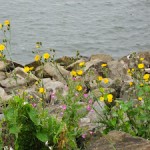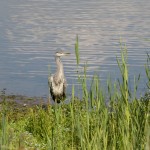According to a small article in the Times yesterday (13th August 2008) the dolphin friendly labelling on tins of tuna has been a huge success. However, there is a concern that the fishing methods that are used are still harmful to other marine creatures such as turtles. Additionally, tuna are also under threat as the methods employed catch large numbers of immature tuna, this bycatch annually killing approximately 100 000 tonnes of fish unnecessarily (this equates to about 10 per cent of everything caught). Campaigners are now calling for improved labelling which will also take into account the effect that the fishing methods has on all marine life.
Category: Nature
Interesting Articles
Just a quick note to point out a couple of interesting articles that I saw in the Times newspaper today (12th August).
First of all the good news is that the ban on whaling has resulted from humpback whales being removed from the at risk list and are now catergorised as being on the lowest level on the endangered scale. In the last 15 years numbers have increased from 17,600 to 40,000. However, there are other residents of our oceans who are still endangered, including various species of whale and porpoise.
On a different note, my beloved has become vindicated. Some time ago he predicted that it would not be long before we were mining landfill. Apparently many waste consultants are now saying that the increasing cost of plastics is bringing this closer to being a reality. It is already happening in the US, and it is thought that the landfills in the UK many of which have been in use for up to thirty years could yield up to 200 million tonnes of plastics. However, this may be delayed until 2020 as the methane emitted from the decomposition of decaying waste is syphoned off as an alternative energy source.
Nature in the rain.
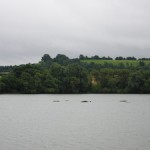
It is meant to be high Summer, but it feels more like autumn; the light is not exactly brilliant (not sure a pun was intended), the monotonous call of the chiffchaff has been replaced by the tic of the robin, the rose hips and hawthorn berries are starting to turn red and, there is a lot of rain about. Still, this is no reason to stay indoors when all seems dull outside.
I took my new, lightweight pair of binoculars for a test drive at the Country Park today. I bought them a few weeks ago, but had so far not had any reason to use them. As expected the Country Park was wonderfully quiet on the visitor front, but still with plenty to catch one’s attention. The water was alive with gulls and geese, with a huge group of swans at the far end. Darting over the water wheeling and turning, almost touching the water and pulling away at what seemed to be after the last moment were the swallows and house martins reminding me that it was still Summer. The terns were also very much in evidence, gliding on the wind that is a permanent feature of Daventry or sitting on the purpose built raft.
In places there were splashes of colour, such as these yellow flowers, glowing, despite the rain, looking brighter when viewed against the dark rocks and the black-looking water. I hadn’t noticed these the first time I walked past them, I was too intent looking at the swooping swallows and house martins. I often find that reversing the direction in which I am walking gives a completely different view and outlook, leading to a whole different visual experience.
The highlight of my walk was a treecreeper that was most obliging, twining its way around the lowest branch of a large oak tree, just by the main path. These are exquisite birds, if you are lucky enough to get a good view, preferably through a good pair of binoculars, you will be startled by the delicate colouring, the many shades of brown that add up to make a beautiful little brown and white bird. Listen for the quiet squeaking and look at the trunk and branches to see a little bird spiralling around probing the cracks and fissures in the bark with its curved beak, looking for insects.
So, in conclusion, my new pair of binoculars are excellent, the weather may be dull and damp, but the wildlife is still out there, waiting to be seen. After all, if the birds stayed at home every time it rained they would soon starve to death, and the trees and flowers can’t up sticks (another unintended pun – sorry!) and look for shelter.
The ladybirds came, and the ladybirds went.
A while ago I posted an article about a lack of ladybirds in my garden as well as other insects in general. However, a couple of weeks ago, they arrived en masse (seemingly from nowhere although that was obviously not the case, I just hadn’t noticed them) and settled on the golden hop in the back garden, a traditional haunt of thousands of aphids.
As you may be aware, there has been a lot of press coverage (unusually so for something like a ladybird) of the ‘invasion’ of harlequin ladybirds (Harmonia Axyridis). These ladybirds originate in Asia and have spread (sometimes with our help and knowledge, e.g. they were introduced as pest control agents in some areas) and are thought to have arrived in Britain in 2004. The spread of the harlequin is concerning as it is thought to be a threat to our native species for a number of reasons:
- they have a wider habitat and food range than natives, this includes moth and butterfy eggs and fruit juice
- they disperse over larger areas, rapidly increasing their geographic spread
- when there are fewer aphids about they will eat other ladybird larvae and eggs
- they have a longer breeding season than native ladybirds and so have the potential to increase their numbers more rapidly (they can reproduce after 5 days of adulthood and a single female can lay 1000 eggs)
I spent some time watching the ladybirds wondering if any were harlequins and, if there were, would I recognise them. The answer was yes, and yes. At first glance it can be quite confusing, there are so many different looking ladybirds, not just the traditional two and seven spot ladybirds, there are also black (melanic) forms as well as more yellow and brown ladybirds. However, once you spot a harlequin it is obvious, they are huge in comparison as are the larvae which seem to have more red on them.
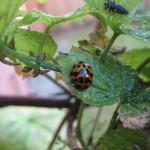
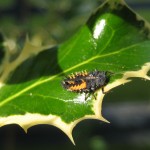
If you still feel you need further help there are two fantastic identification charts on the ladybird survey website, one for larvae and one for adults. It is from these that I discovered I had a cream spot ladybird in amongst the two spots.
I was lucky enough to see the ladybirds in all stages of their development. There were larvae of all sizes chasing aphids across the leaves and the top of my wormery. The holly that is next to the golden hop seemed to be a favourite place for pupation and is littered with the cases of what I presume are now adult ladybirds. And, of course there were the myriad of adult ladybirds. I spent quite some time watching a black harlequin (H. axyridis spectabilis) chasing some greenfly along the top of a crocosmia flower stem. Whilst the ladybird wandered along the top and snacked on one of its unfortunate (although I can’t really feel sorry for them) victims its friends escaped along the bottom of the flower!
The ladybirds stayed around for a few days, but then, the rains came, the aphids went (possible eaten) and the ladybirds disappeared as quickly as they had arrived. Since that time I have seen only a couple of two spots in the garden. I did manage to take some photos of the ladybirds, two of which I have included below.
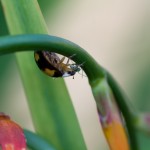
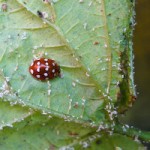
Wanted: For Crimes Against My Brassicas!
So, the sun is finally making an appearance and warming the air (in my opinion a little too much at times), allowing the butterflies to come out without fear of drowning. It is high Summer, the buddlejia is flowering, the sky is sometimes blue and the garden is brought to life by the droning of bees (although reportedly fewer than in previous years) and the fluttering of delicate wings looking for some nectar producing plants on which to land.
Oh and the evil white butterflies that don’t stop long enough for me to take a picture, who are not looking for nectar. No, they are looking for my young cavolo nero that I am growing for the winter. They hunt round and round, stopping only briefly when they spot something in the brassica family that they can oviposit on (is that a verb – not sure?).
Many an allotment is covered in netting to keep these devil insects at bay, but, should I use these in the garden – not very pretty! I am resorting to regular checks of my plants. This is where I may have the advantage over the allotment holders, I only have eight plants, and so a regular check is not so time consuming. So far I have been evaded by two caterpillars who munched their way through the majority of two plants, but, in the main I have managed to remove most of the eggs. If this doesn’t work this year I may have to resort to a shotgun next year! I have included a couple of pictures below of the white butterfly that is out to get my brassicas (not the actual one, I have had to resort to a picture that I took the other year) and the reason they are so naughty.
Brandon Marsh
On the way back from Ryton I called in to Brandon Marsh nature reserve to see if there were any insects or flowers about that would present a photo opportunity (for that read: I had a camera and no binoculars or scope with me).
I wasn’t expecting much in the way of birdlife, Brandon is often an all or nothing place but I was hopeful of some damselflies. Â What was there? Â Well, not much, one elusive dragonfly and some comma and white butterflies amongst the brambles with nothing overly exciting from a botanical point of view. Â From an ornithological point of view there seemed to be more birds about than normal at this time of year when many of the areas are completely empty. Â The highlight were green sandpipers and oystercatchers (the latter easy to recognise even without optical gear). Â
I became more hopeful when I reached the Carlton hide which is usually deserted, but on Saturday was filled with birdwatchers and photographers. Â However, I think they were there in the hope of seeing and photographing a kingfisher or hobby rather than because of something that was actually there. Â The massed ranks were satisfying themselves with shooting (in a photographic sense) a heron that seemed to be posing for them. Â Not having the patience to wait for a bird that may or may not turn up and not having a gigantic lens requiring a sherpa to help move it I wandered off to look for other things.
 I had to satisfy myself with this photo of a different heron.
Not all slugs are bad really.
For the most part, slugs are my nemeses. They attack my attempts at growing my own food, they decimate my flowers and they leave a slimy mess everywhere. Once they hit a certain size they seem to have very few enemies (apart from gardeners and their friends the hedgehogs). However, not all slugs are bad, one of the less destructive slugs is the rather pretty tiger slug.
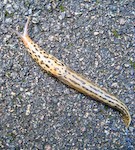 The tiger slug, is also known as a leopard slug (Limax Maximus) for obvious reasons. Â These large slugs (they can grow up to 16cm in length) are relatively common throughout Britain and Ireland and are usually found in gardens and woodlands. Â They tend to feed on decaying matter and fungi (and, allegedly other slugs) so, next time you see one of these not so little chaps, maybe think twice before ‘dealing’ with them!
The tiger slug, is also known as a leopard slug (Limax Maximus) for obvious reasons. Â These large slugs (they can grow up to 16cm in length) are relatively common throughout Britain and Ireland and are usually found in gardens and woodlands. Â They tend to feed on decaying matter and fungi (and, allegedly other slugs) so, next time you see one of these not so little chaps, maybe think twice before ‘dealing’ with them!
Waterboatmen
This year, for the first time, we have lots of waterboatmen living in/on our pond.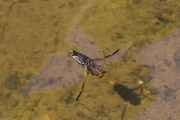 Yesterday the weather was sunny enough for me to be able to get an OK picture of them without having to get the tripod out.
Yesterday the weather was sunny enough for me to be able to get an OK picture of them without having to get the tripod out.
I thought it would be a nice idea to learn more about these little creatures, but then I entered a world of confusion. There are apparently lesser waterboatmen which do not bite, but which do not swim upside down. This is obviously not true of my friends (not sure about the biting though), these therefore looked as though they may be ‘backswimmers’ – never heard of them, but they are apparently all over the US (unlike myself – that would be a stupid idea). I then trawled around the web a bit more and found a bit more info on the BBC website. This looks as though it is a Greater Waterboatman (or backswimmer); notonecta glauca , they live in ponds and canals, are quite predatory and eat tadpoles (they are out of luck in my pond) and the larvae of diving beetles (these seem to be in shorter supply this year, I may now know the reason why). They are also known to bite, their saliva is toxic and they are not related to the lesser waterboatman. I am not sure how I feel about these now, I am a little concerned about my diving beetles and tadpoles to be.
First Dragonfly of the Year
A wander around the garden today (making the most of the sunshine) produced a few surprises and some quick photo opportunities.
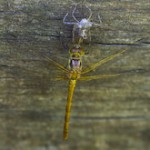 The first of these was the emergence of a common darter (I think) from the pond. I disturbed one of them, but I think that this one needed a little more time to dry its wings so I grabbed a quick shot. This was the first I had seen this year.
The first of these was the emergence of a common darter (I think) from the pond. I disturbed one of them, but I think that this one needed a little more time to dry its wings so I grabbed a quick shot. This was the first I had seen this year.
The nymph stays in the pond for up to a couple of years, and then crawls out to emerge as the predatory adult. The common darter changes colour to more of a brick red as it suns itself.
No culling?
As you may be aware, the government has finally made a decision with regard to the culling of badgers to prevent the spread of TB in cattle. Â As far as I am concerned this is a good move mainly as there seems to be no scientific evidence to back up the belief that culling badgers will reduce the spread of TB in cattle. Â Although it must be difficult for farmers faced with a heard infected with TB the numbers destroyed each year at about 12000 are tiny in comparison with the number of cows in the country which stands at several million. Â However, the government should compensate farmers to a fair level and, just as importantly, in a timely manner.
What is more worrying is that some farmers are threatening to ignore this and start killing badgers on their land. Â What would happen if we all found a law or ruling that we don’t like and decided to ignore it? Â There have been a lot of reports in the media recently about poor payment to farmers from the major supermarkets which has helped to raise sympathy for farmers, but I am sure that the culling of badgers by farmers in spite of this ruling will negate all the recent improvements in the public image of our farmers.Â
